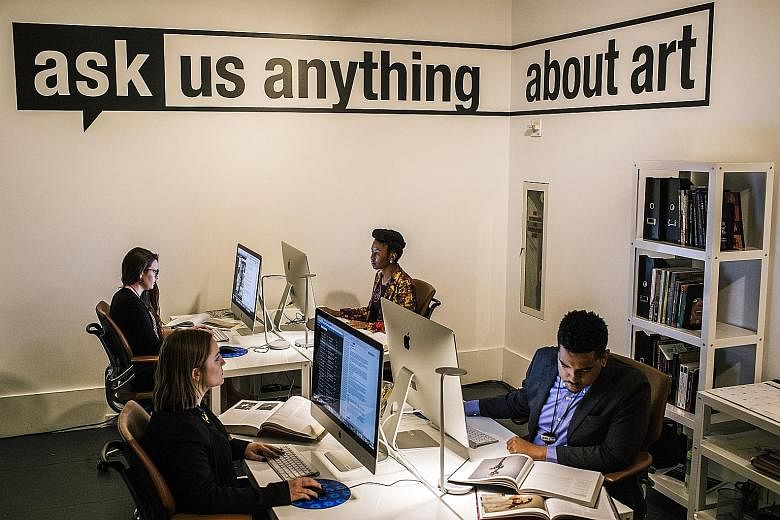NEW YORK • When Juwan Stallings visited the Brooklyn Museum last weekend, he wanted more information about the subject of an oil portrait by Henri Fantin-Latour in the museum's newly refurbished European galleries.
Mr Stallings, 19, looked intently, snapped a photo and then typed rapidly on his phone. Within seconds, he had an answer in the form of a text message.
"Hi there! That's Madame Leon Maitre," it read, continuing, "I love comparing her to some of the other portraits of women on that wall - the others really confront the visitor, while Madame Leon Maitre looks demure and quiet."
The answer came from a museum employee two floors down, one of six full-time staff members dedicated to engaging with visitors through the museum's smartphone app, ASK Brooklyn Museum.
First released for iPhone last year, with an Android version made available this month, ASK is startlingly different from most museum apps. There is no audio guide, no map and no store. You cannot search the collection. Nor can you use it to share your experience on social media.
What you can do with it is chat with a member of the ASK staff, who is trained to help visitors engage more deeply and make personal connections with what is on display. It is like having a curator in your pocket: When you send a question or a comment, a team member can see where in the museum you are and what artworks are nearby. After providing an answer, the staff member often follows up with a personal observation or a question to prompt closer examination.
Asked if he visited the museum often, Mr Stallings said he had not in the past.
"But now I'm starting to, because the questions that I have can be answered," he said.
Visitors may be tentative at first. But once they try it, they tend to keep going. The average user sends 13 messages during a visit, said Ms Shelley Bernstein, the museum's vice-director for digital engagement and technology.
She said: "The hidden power of it is in the other stuff that's happening."
All of the user chats are retained for future conversations in the app and as a resource for curators. This month, the museum reopened three of its permanent-collection galleries after reinstalling them, one of the first visible shifts since Ms Anne Pasternak became the museum's director last year. Curators consulted ASK data before making their changes.
They realised, for example, that visitors to the Egyptian galleries were asking a lot of questions about an image of the ancient zodiac that was painted on the ceiling as a decorative element in 2003. The painting was removed during the reinstallation to shift the focus towards the museum's rich collection of artefacts, such as the ancient Head From A Female Sphinx. This emphasis on studying visitors' reactions reflects a significant philosophical shift.
"Curators, 35 years ago, were not interested in what the public needed - they were interested in what the curators thought the public should have," said Mr Kevin Stayton, deputy director of the museum and its former chief curator.
"Having this conversation with the visitor was something that we really didn't think about."
Each member of the audience engagement team has a major and a minor speciality area and a rich library of reference material at hand. They are encouraged to use a casual tone and to share their own opinions freely.
Personalised communication is important for younger visitors, said Mr Matthew Fisher, a principal at Night Kitchen Interactive, a Philadelphia firm that has designed apps and interactive elements for dozens of museums.
"Digital natives are more interested in actively synthesising than in passively receiving information," he said.
The ASK app is free and does not require any registration or login. It works only inside the museum, which does not collect personal data from users, although the ASK team can gain access to a user's previous chats.
That approach is unusual among museum apps, which are often larded with images and text.
But a significant hurdle remains: In the first year of iPhone-only testing, about 10,000 people downloaded it. But only 1 per cent of museum visitors were using it.
The museum hopes to raise that figure to 5 to 7 per cent through its new Android phone capability, with a brand new desk for the ASK team in a high-traffic area right off the lobby and by stationing employees in the lobby to talk up the app.
The project is supported by funding from Bloomberg Connects, which has pledged more than US$80 million (S$107 million) to 15 cultural institutions to improve visitor experience through technology. Among the other grant recipients are the Guggenheim Museum, the Museum of Modern Art and the Tate Modern in London.
NEW YORK TIMES

